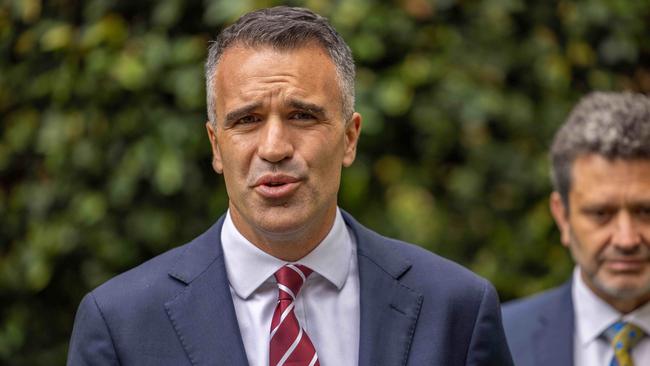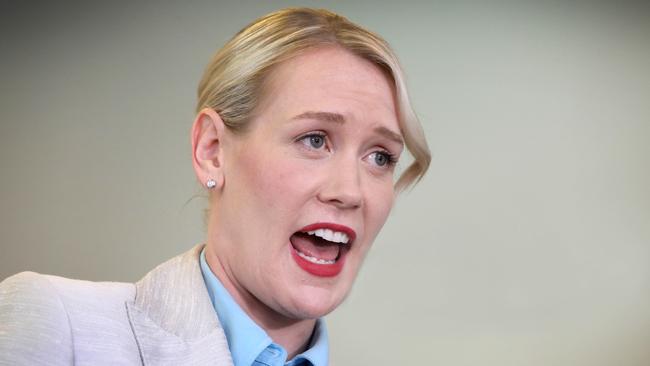Peter Malinauskas’s puzzling shot at Ashton Hurn suggests ramping’s got Labor rattled | David Penberthy
No matter how many caveats the Premier puts on it, ramping is really not going anywhere, writes David Penberthy.
Opinion
Don't miss out on the headlines from Opinion. Followed categories will be added to My News.
How do you manage a promise which was so grandiose that it guaranteed you election victory but which remains so unfulfilled that it could hurt you at the next poll?
This was the challenge Peter Malinauskas grappled with this week as he valiantly attempted to declare his ramping promise an overall success.
He did so by two means – cherrypicking the bits of the promise which have succeeded, and recasting the intention of the original pledge.
There is a private view among Labor hardheads that the only real threat to the ongoing viability of the Malinauskas Government is its promise on ambulance ramping.
To wind back to 2022, if anyone needs reminding, the promise plastered on every second Stobie pole in SA was simple.
“Labor will fix the ramping crisis”.
The finer detail on the promise, as outlined by Malinauskas ahead of his 2022 victory, was to return ramping to the same levels when the Marshall Government was elected in 2018.
It worked a treat electorally but it was a crazy-brave pledge.
And with just over a year to go until the 2026 election, Labor’s honouring of that promise takes on greater importance and urgency.
In our first interview of the year with the Premier, his answers revealed Labor’s strategic thinking in dealing with that question.
The strategy is to declare it a success anyway, even if it still has not been honoured as outlined in 2022.

In fairness to Malinauskas, he at least prefaced his remarks with an admission that more still needed to be done as more beds came online.
“I am not saying it’s fixed, I think there is a long way to go. We have still got a heap of improvement to do at the RAH and also at Flinders,” he conceded.
But then in his mind it was all good news. With the massive exception of the state’s two biggest hospitals, things are going well.
And things look even better when you compare the current ramping figures not with those from the Marshall era, but the record highs achieved on Malinauskas’ own watch in 2022 and 2023.
Asked to admit that last December’s ramping figures showed a disturbing upward trend, Malinauskas was instead upbeat.
“December was better than December prior,” he said.
“And then that was true going back for November, October, September. Particularly October and November we saw a heap of improvement.”
This is a cute distinction, whereby instead of campaigning against the shocking numbers clocked up by Steven Marshall, Mali is now campaigning against the shocking numbers he clocked up himself the year before.
The other part of the tactic involves some deliberate what-aboutism, where the minor trifle of the RAH resembling a carpark is brushed aside with the apparently headline-grabbing achievements at the Lyell McEwin.
“The one we are really happy with is the Lyell Mac,” he said. “Throughout 2022 and 2023 we saw ramping improve there dramatically as soon as we brought those new beds online, which was in August last year when ramping dramatically improved.”
The takeout from this is clear.
If you’re in an ambulance having chest pains and heading to North Tce, ask the driver if he knows the way to Elizabeth Vale instead.
The other part of Labor’s promise-management strategy is to recast its 2022 pledge not as fixing the ambulance crisis – which means getting people out of ambulances and into beds – but fixing ambulance response times.
Asked specifically and purely about whether the ramping promise had been met, the Premier said this: “It’s certainly improved in terms of the stated objective which we were clear about in the lead to the election and that was to improve ambulance response times.
“Three years ago you called triple-0 and over 60 per cent of the time the ambulance rolled up late for a lights and siren emergency. Now the opposite is true. Seventy per cent of the time the ambulance is on time.”
Now I must have misread the election posters, but I really can’t remember Labor saying that. It was all about ramping, not ambulance response times, meaning more people out of ambulances and in actual beds.
It also invites the dead obvious logical point that if you haven’t got more operational beds and enough medicos to staff them, faster ambulance times mean you will end up in a carpark quicker than you did when the Liberals were in charge.
You have to credit the Premier for a level of honesty bordering on chutzpah when he said: “I am naturally highlighting where we have seen improvement.”
You don’t say.

The most puzzling part of the Premier’s interview was his decision to name and denounce shadow health spokeswoman Ashton Hurn several times over her claim that the government was fudging the criteria by which ramping was being measured for political ends.
Normally an incumbent government with a commanding lead will pretend that the opposition does not even exist.
His naming of Hurn suggests that either the tenacious health spokeswoman has got under Labor’s skin, or that party strategists believe there is merit in talking her up to destabilise the Liberal leadership.
The latter strategy would be a foolish one, as she is the one person on the Liberal side who has landed consistent blows on Labor on one of the few issues where it is vulnerable.
And whatever way he slices it, however many caveats the Premier tried to apply, the reality remains that Labor has a snowball’s chance of getting ramping in its totality back to the same levels as a very long eight years ago, in an ageing state, with meth addicts clogging up EDs, along with innocent, unwell punters unable to find or afford a GP.
The 2022 promise is now more a case of “at least we’re trying, some of it has worked, and this is a problem everywhere in Australia”. It’s not quite “vote like your life depends on it”, but it will probably have to do.
More Coverage
Read related topics:Peter Malinauskas





